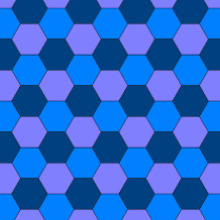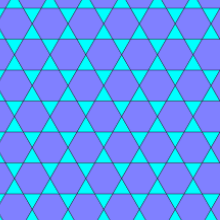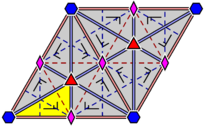Hexagonal lattice
 |  |
| A hexagonal or triangular lattice of points | |

The hexagonal lattice or triangular lattice is one of the five 2D lattice types.
Three nearby points form an equilateral triangle. In images, four orientations of such a triangle are by far the most common. They can conveniently be referred to by viewing the triangle as an arrow, as pointing up, down, to the left, or to the right; although in each case they could also be considered to point into two oblique directions.
Two orientations of an image of the lattice are by far the most common. They can conveniently be referred to as "hexagonal lattice with horizontal rows" (like in the figure below), with triangles pointing up and down, and "hexagonal lattice with vertical rows", with triangles pointing left and right. They differ by an angle of 30°.
The hexagonal lattice with horizontal rows is a special case of a centered rectangular (i.e. rhombic) grid, with rectangles which are √3 times as high as wide. Of course for the other orientation the rectangles are √3 times as wide as high.
Its symmetry category is wallpaper group p6m. A pattern with this lattice of translational symmetry cannot have more, but may have less symmetry than the lattice itself.

For an image of a honeycomb structure, again two orientations are by far the most common. They can conveniently be referred to as "honeycomb structure with horizontal rows", with hexagons with two vertical sides, and "honeycomb structure with vertical rows", with hexagons with two horizontal sides. They differ by an angle of 90°, or equivalently 30°.
A honeycomb structure is in two ways related to a hexagonal lattice:
- the centers of the hexagons of a honeycomb form a hexagonal lattice, with the rows oriented the same
- the vertices of a honeycomb, together with their centers, form a hexagonal lattice, rotated by 30° (or equivalently 90°), and scaled by a factor , relative to the other lattice
The ratio of the number of vertices and the number of hexagons is 2, so together with the centers the ratio is 3, the reciprocal of the square of the scale factor.
The term honeycomb lattice could mean a corresponding hexagonal lattice, or a structure which is not a lattice in the group sense, but e.g. one in the sense of a lattice model. A set of points forming the vertices of a honeycomb (without points at the centers) shows the honeycomb structure. It can be seen as the union of two offset triangular lattices, shown here red and blue.
 2 triangular lattices |
 3 triangular lattices |
A triangular lattice itself can be divided into 3 offset triangular lattices, shown above in red, green and blue. A triangular lattice is also called an A2 lattice, A2,[1] and the union of three triangular lattices is A*2.[2]

In addition to these points, or instead of them, the sides of the hexagons may be shown; depending on application they may be called lattice bonds.
With respect to a hexagonal lattice we can distinguish two sets or three directions:
- the directions of the smallest distance between lattice points; let us call them the main translation directions
- the directions of the second smallest distance between lattice points; let us call them the secondary translation directions; these distances are √3 times as large. The set of lattice points can be partitioned into three sets with these larger translation distances.
Within each set of directions the directions differ by an angle of 60°, and between sets by angles of 30° and 90°. For a hexagonal lattice with horizontal rows one of the three directions is horizontal, and for a hexagonal lattice with vertical rows one of the three directions is vertical.
Conversely, for a given lattice we can create a rotated lattice that is √3 times as fine by adding the centers of the equilateral triangles. Since there are twice as many triangles as vertices, this triples the number of vertices.

A pattern with 3- or 6-fold rotational symmetry has a lattice of 3-fold rotocenters (including possible 6-fold rotocenters) that is this finer lattice relative to the lattice of translational symmetry.
In the case of 6-fold rotational symmetry the 6-fold centers form a lattice as coarse as the lattice of translational symmetry, i.e. there is one 6-fold center and there are two 3-fold centers per primitive cell.
For reflection axes, there are two possible sets of directions, mentioned above. In the case of 3-fold symmetry either none (p3) or one of the two applies:
- p3m1 with reflection axes along the shortest connections between the rotocenters
- p31m in the main translation directions
In the 6-fold case either none (p6) or both (p6m) apply.
If there are reflection axes in the main translation directions, one of the three sets of rotocenters play a different role than the other two: these reflection axes pass through them. With p6 one set is special because of being 6-fold.

See also
- Square lattice
- hexagonal tiling
- close-packing
- centered hexagonal number
- Eisenstein integer
- Voronoi diagram
- Loewner's torus
References
- Born, M.: "On the stability of crystal lattices. IX. Covariant theory of lattice deformations and the stability of some hexagonal lattices". Proceedings of the Cambridge Philosophical Society 38, (1942). 82–99.
| Wikimedia Commons has media related to Hexagonal lattices. |